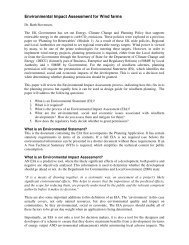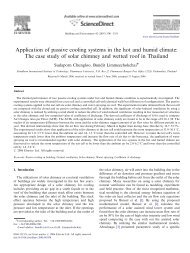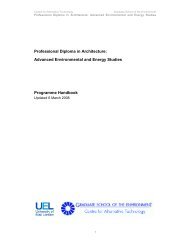Module B1 Study Book - the Graduate School of the Environment
Module B1 Study Book - the Graduate School of the Environment
Module B1 Study Book - the Graduate School of the Environment
You also want an ePaper? Increase the reach of your titles
YUMPU automatically turns print PDFs into web optimized ePapers that Google loves.
Reducing output from a source that produces at almost zero marginal costs<br />
might sound odd. But <strong>the</strong> flexibility <strong>of</strong>fered by wind turbines can be very<br />
valuable for an electricity system, as <strong>the</strong> alternative <strong>of</strong> shutting down or partloading<br />
coal and combined cycle gas turbines implies higher energy and<br />
maintenance costs for subsequently heating <strong>the</strong>m up. New tariff systems or<br />
contractual arrangements could make this a real option.<br />
Costs <strong>of</strong> wind power integration<br />
Strbac et al. (2002) were commissioned by <strong>the</strong> UK Department <strong>of</strong> Trade<br />
and Industry (DTI) to carry out a study 'Quantifying <strong>the</strong> System Costs <strong>of</strong><br />
Additional Renewables' to <strong>the</strong> UK electricity grid in 2020 (also known as <strong>the</strong><br />
SCAR report).<br />
In a scenario using a mix <strong>of</strong> biomass and wind, it was found that <strong>the</strong> total<br />
additional system costs per year for a 20% renewables share were €205m<br />
(£143m) in 2020, translating into total additional system costs <strong>of</strong> €4.9 per<br />
MWh <strong>of</strong> renewable electricity compared to current wholesale electricity prices<br />
in <strong>the</strong> UK <strong>of</strong> about €47 (£32).<br />
The highest additional system costs were found for a scenario where <strong>the</strong><br />
renewables share would come predominantly from wind, mostly located in<br />
Scotland and <strong>of</strong>f-shore, far away from load centres. Here <strong>the</strong> per annum<br />
additional system costs would be €570m (£398m) in 2020, translating into<br />
total additional system costs <strong>of</strong> approximately €14 per MWh <strong>of</strong> renewable<br />
electricity, in this case almost entirely from wind.<br />
C. Decentralised energy [DE]<br />
With thanks to Greenpeace report: Decentralising power: an energy revolution<br />
for <strong>the</strong> 21st century.<br />
‘In <strong>the</strong> early years <strong>of</strong> <strong>the</strong> new millennium, <strong>the</strong> electricity system, <strong>the</strong><br />
bloodstream <strong>of</strong> industrial society, is going to change almost beyond<br />
recognition. It will have to.’<br />
Walt Patterson, Royal Institute <strong>of</strong> International Affairs<br />
What is it, in principle?<br />
http://www.<strong>of</strong>gem.gov.uk/temp/<strong>of</strong>gem/cache/cmsattach/10 20_<br />
factsheet0602_27feb.pdf<br />
Lecture: Britains Power System 99











